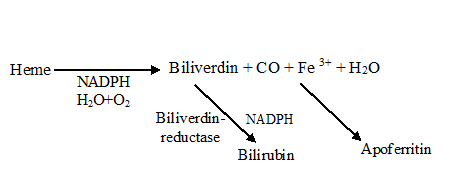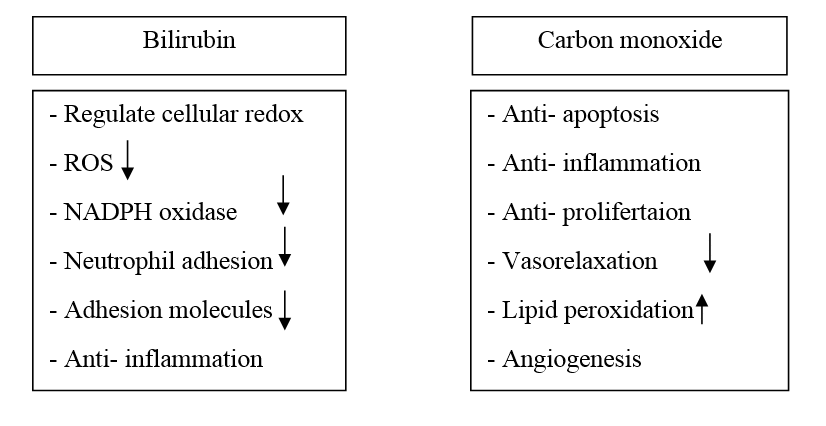Effects of exercise on heme oxygenase (HO)
Exercise-induced production of ROS is proposed to cause specific adaptations such as increasing repair mechanisms for increasing resistance to oxidative stress, and lowering levels of oxidative damage. The nuclear factor- like 2 (Nrf2) has been shown that have a critical role against oxidative stress. A variety of activators, including oxidative free radicals, have a major role to release and translocate Nrf2 into the nucleus where it regulates the expression of antioxidant enzymes such as NQO-1, glutathione-S-transferase, glutathione peroxidase, and HO-1 (Lee, Park et al. 2011). HO is a rate-limiting enzyme in the catabolism of heme, a process that leads to formation of equimolar amounts of biliverdin, free iron and carbon monoxide (CO). Biliverdin rapidly convert to bilirubin (Figure 3). Three isoforms of HO have been identified: HO-2 and HO-3 are constitutively expressed isoforms. An important role of HO-1 in the antioxidant defense system arises from an induction of ferritin synthesis that diminishes the cellular pool of free iron and also from the enhancement of bilirubin levels, which are potent antioxidants. Both biliverdin and bilirubin play an important role in endothelial cell integrity.

Figure 3. Schematic representation of the heme degradation process
The biological actions of bilirubin may be especially relevant to the prevention of oxidant-mediated cell death. Bilirubin at a low concentration scavenges ROS in vitro, thereby attenuating oxidant stress and reducing oxidant- mediated cellular damage in vivo. Bilirubin is implicated in reducing oxidative stress in experimental diabetes, in part, by increasing the bioavailability of NO needed for endothelial cell integrity. Bilirubin mediated inhibition of PKC and NADPH oxidase may be one mechanism by which HO-1 attenuates the diabetes- mediated generation of oxidants and the uncoupling of eNOS. Glucose enhances O2- production, leading to increased vascular formation of the NO/O2- reaction product peroxynitrite (ONOO-). HO-derived CO has been identified as playing a role in many processes related to vascular control and tissue viability. Similarly to NO, CO is considered a vasorelaxant via stimulation of cGMP. The vasodilator effect of CO may be dependent on the level of NO (Figure 4).
Sun et al. found that acute and chronic endurance exercise was associated with not only elevated eNOS but also increased vascular HO-1/HO-2 and enhanced HO-related vasodilation. They demonstrated close interaction between HO and NOS enzyme systems. In addition to their antioxidant effects, the NOS and HO systems may exert synergistic action in regulating vascular relaxation (Sun, Zhong et al. 2008).

Figure 4. Schematic representation of the role of bilirubin and carbon monoxide in cardiovascular system